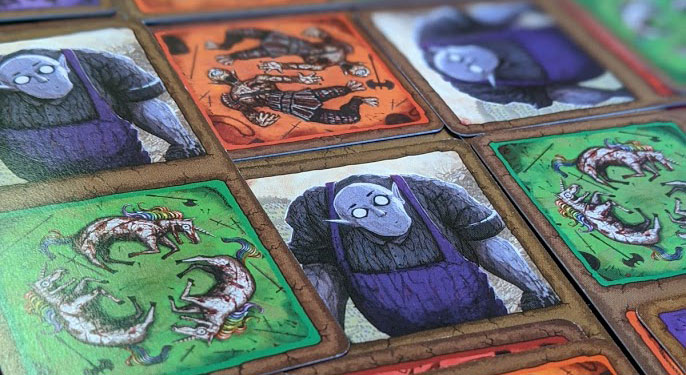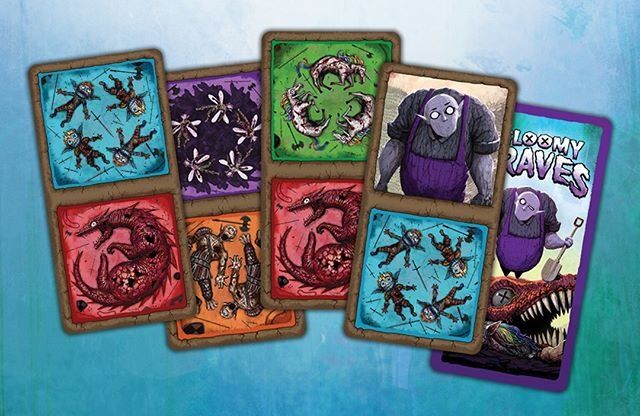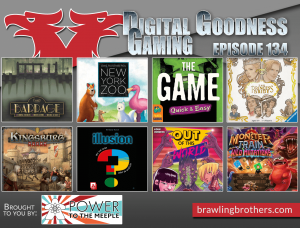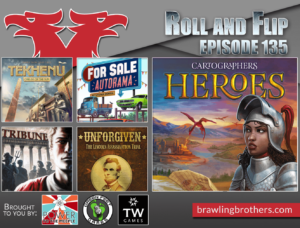Gloomy Graves Board Game Review
Gloomy Graves
Publisher: Renegade Game Studios
Designer: Jeffrey D. Allers
Artist: David Szilagyi
Players: 2-4
Play Time:30-45 Minutes
Reviewer : Noel Szczepanski
BGG Score (at publication): 7.0 – 8,449 Overall
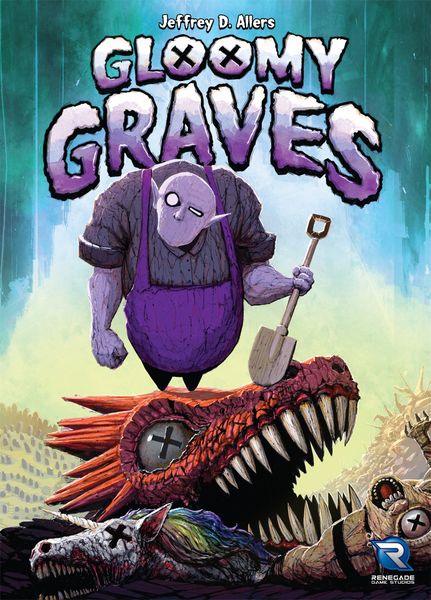
HOW TO PLAY GLOOMY GRAVES
Players start Gloomy Graves with five cards, one of which they will play face down in their personal tableau thus they will start the game with four cards in their hand. The cards are divided into two “plots” with each plot being one of the five colors or a gravedigger (wild); no card has two of the same color on it. Before the first player takes their turn, everyone reveals their face down card and two cards are flipped over from the draw deck to form the public playing area.
On your turn your will play two cards – one to the public area and one to your personal tableau. When you play to the public area, the card you play must overlap exactly one “plot” (may not cover two or zero) of a card already in the public area. You may not cover a gravedigger except with another gravedigger, otherwise all other placements are legal. Your personal tableau may not exceed a 3×3 area or have more than a single gravedigger in any column or row, but when you place a card it MAY cover anywhere between 0 – 2 plots.
After you play your two cards, you may choose to score one of the colors that matches one of the plots on the card you played to the PUBLIC tableau. If one of the plots was a gravedigger, you may instead choose to score any color.
To score, add up the contiguous plots of the chosen color in your personal tableau as well as those in the public tableau to determine which scoring card you may claim. Each player may claim, at most, one of each color so you may choose to forgo scoring to try to reach a higher value scoring card in a subsequent round.
Gloomy Graves ends either when a player has completed all five plots, or when the draw deck runs out. Players add up the points on the scoring cards they claimed and score an additional bonus if they claimed 3+ scoring cards.
VARIABILITY / AGENCY
Gloomy Graves has extremely low variability. The variable setup is limited to the two cards that are revealed in the public tableau at the beginning of the game.
In terms of agency, players may draw from the four face up public cards or from the top of the draw pile to refill their hand which provides them with a decent amount of agency. Players may lose agency in the form of consistently poor options and bad draws combined with their opponents’ ability to block them. There is no output randomness.
PRESENTATION: PRODUCTION / GRAPHIC DESIGN / ART / THEME/SETTING
The production in Gloomy Graves is fine. The cards are thin and odd shaped, and probably un-sleeveable, but they serve their purpose for the game to work; better card quality, or a different card-size probably wouldn’t have worked.
The graphic design in Gloomy Graves is good, and the game is color-blind friendly. The cover art on the box is good and representative of the theme. The card art isn’t as catching and is a bit of a detractor as players will comment on the morbidity of the cards. This game would have benefited from a lighter, more child-appropriate theme given that it is a family-weight game.
GLOOMY GRAVES BOARD GAME REVIEW
Gloomy Graves is a decent board game, but it is too simplistic for an involved strategy game and perhaps a bit too long for a filler game. The “theme”, and especially the art, is a detractor. There appears to be a slight turn-order advantage in Gloomy Graves with the first player having a disadvantage, as it is much easier to combo off the cards played by the players who precede you to score bigger cards than they did. This can be very slightly mitigated if earlier players commit to multiple colors and then pivot early on to one that the player following them hasn’t committed to yet, but this is only viable if all of, or most of, the other players are doing it. In our plays, first player never won.
Noel Szczepanski
Data Lord & Board Game Reviewer
Noel Szczepanski is an avid boardgame enthusiast who regularly posts on BoardGameGeek, Facebook and elsewhere on Social media. Noel regularly games with the Brawling Brothers where he tracks, organizes and analyzes all of the data used on the Brawling Brothers Boardgaming Podcast. Noel’s written reviews and additional contributions can be viewed here.
Note: The thoughts and opinions expressed in this review are those of the authors alone and do not necessarily reflect the thoughts and opinions of the Brawling Brothers. Any content provided by our bloggers or reviewers are of their opinion and are not intended to malign any religion, ethnic group, club, organization, company, or individual.

